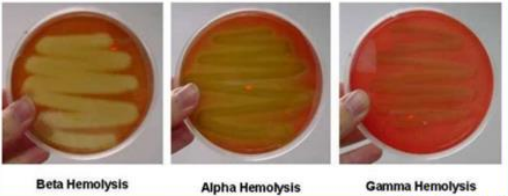Bacteriology Primer
Bacteria lack a nucleus, but contain a nucleoid (circular DNA). No organelles, so function carried out by plasma membrane. Bacteria which are gram positive (+) have a thick cell wall while those which are gram negative (-) have a thin cell wall.
Components
Capsule
Slime/glycocalyx external to cell wall. Present in both gram (+)/(-) bacteria.
Some encapsulated bacteria can evade the complement cascade:
Some Killers Have Pretty Nice Capsules
- Streptococcus pneumoniae
- Klebsiella pneumoniae
- Haemophilus influenzae
- Pseudomonas aeruginosa
- Neisseria meningitidis
- Cryptococcus neoformans
Cell Wall
Largely peptidoglycan and repeating N-acetylated muramic acid (NAM)/N-acetylated glucosamine (NAG). NAM/NAG will form cross bridges in gram (+) bacteria. Gram (-) bacteria have only partial cross links.
Antibiotics can target tetrapeptides (penicillin binding proteins) which are responsible for cross linking.
Outer Membrane
Present only in gram (-) bacteria. The major component is LPS/endotoxin. Also contains pore proteins, as well as transport proteins for metabolites (maltose, vitamin B12, nucleosides, iron, etc.)
Periplasmic space
Only in gram (-) bacteria. Contains binding proteins and plasma enzymes for antimicrobial resistance.
- Beta-lactamase: Breaks down beta-lactam rings of antibiotics
- Aminoglycoside modifying enzymes
Inner Membrane
Proteins and phospholipids. In gram (+) bacteria, also contains lipoteichoic acid.
Pili/fimbriae
Glycoproteins which adhere the bacteria to mucosal and epithelial surfaces. This is how E. coli adheres to the surface of the bladder and causes UTIs.
Flagella
Predominantly in gram (-) bacteria. Responsible for motility. Contains H antigen which is unique to bacteria.
Endospores
Only in gram (+) bacteria. Vegetative/resting state of a bacteria which allows it to survive harsh environments or stress. Contains genome/metabolic machinery and is heat stable. These spores can survive for years.
Types
- Clostridia species (e.g., C. diff)
- Bacillus species (e.g., Bacillus anthracis)
LPS/Endotoxin
Will activate complement system, bringing neutrophils and histamine release (edema, hypotension). It can also cause interferon release and tissue necrosis. It is mitogenic for B lymphocytes. Contains three covalently linked regions.
- Lipid A anchor: Toxigenic
- Core polysaccharide
- O antigen: Immunogenic
Lipid A actives macrophages and upregulates production of cytokines (hypotension) and pyrogens (fever). Can result in circulatory collapse or Septic Shock.
Recognizing Bacteria
Gram (+)
Cocci clusters
Looking like groups of grapes. Presents with fever.
Types
- Staphylococcus aureus (MRSA, MSSA)
- Staphylococcus epidermis
Clinical syndromes
- Infection: Skin/soft tissue, blood, bone/joint
- Endocarditis (heart valve infection)
- Pneumonia
Cocci pairs
Diplococci.
Types
- Streptococcus pneumoniae
Clinical syndromes
- Pneumonia
- Meningitis
- Sinusitis
- Bronchitis
- Otitis
Cocci chains
Streptococci
Alpha-hemolytic
- Viridans streptococci: Exhibits endocarditis.
Beta-hemolytic
- Streptococcus pyogenes (Group A): Exhibits pharyngitis, skin/soft tissue infections. bacteremia
- Streptococcus agalactias (Group B): Exhibits meningitis, bacteremia, VTI, bone/joint infections
Enterococci
Types
- Enterococcus
- Enterococcus faecium (VRE): Exhibits VTI, GI tract infections (hepatobiliary infection, intra-abdominal infection, bacteremia)
Rods (bacilli)
Types
- Corynebacterium
- Bacillus
- Clostridium: Exhibits anaerobic infections
- Listeria monocytogenes: Causes bacterial meningitis in immunocompromised individuals
Gram (-)
Cocci
These only come in diplococci (pairs).
Types
- Neisseria gonorrhoeae: Exhibits STI, urethritis, cervicitis, bacteremia/joint infection
- Neisseria meningitidis: Exhibits meningitis (fatal), bacteremia
Coccobacilli
Types
- Haernophilus influcentae: Exhibits sinusitis, bronchitis, otitis, meningitis, pneumonia
Rods (bacilli)
Most common of gram (-) bacteria. These can either be slender pseudomona aeruginosa or fat and plump enterobacterales.
Types of enterobacterales
- E. coli
- Klebsiella
- Enterobacter
- Citrobacter
- Proteus
Clinical syndromes
- Hospital Acquired Infections (nosocomial)
- HAP
- VTI
- Bacteremia
- Intra-abdominal infections
Bacterial Media
Blood agar plate
For more, see here: Gram Positive Cocci > Laboratory Techniques
Non-selective for gram (+)/(-). Exhibits alpha, beta, and gamma hemolysis.
Alpha will be greenish and test for Streptococcus pneumoniae.
Beta will be white and test for Group A strep (Streptococcus pyogenes).
Gamma will have no hemolysis and test for enterococci.

MacConkey Agar
Selects gram (-) bacteria. Distinguishes between lactose/non-lactose fermenters.
Lactose fermenters (pink/red colonies)
- E. coli
- Klebsiella
- Enterobacter
- Citrobacter
Non-lactose fermenters (transparent/colorless colonies)
- Salmonella
- Shigella
- Proteus
- Providencia/Morganella
- Pseudomonas aeruginosa (requires special treatment)
- Stenotrophomonas maltophilia
Chocolate Agar
Contains a lot of nutrients and promotes bacteria requiring specific nutrients (fastidious). It will select Haemophilus species (AKA Neisseria species).